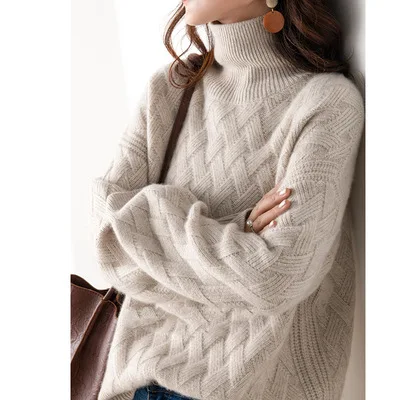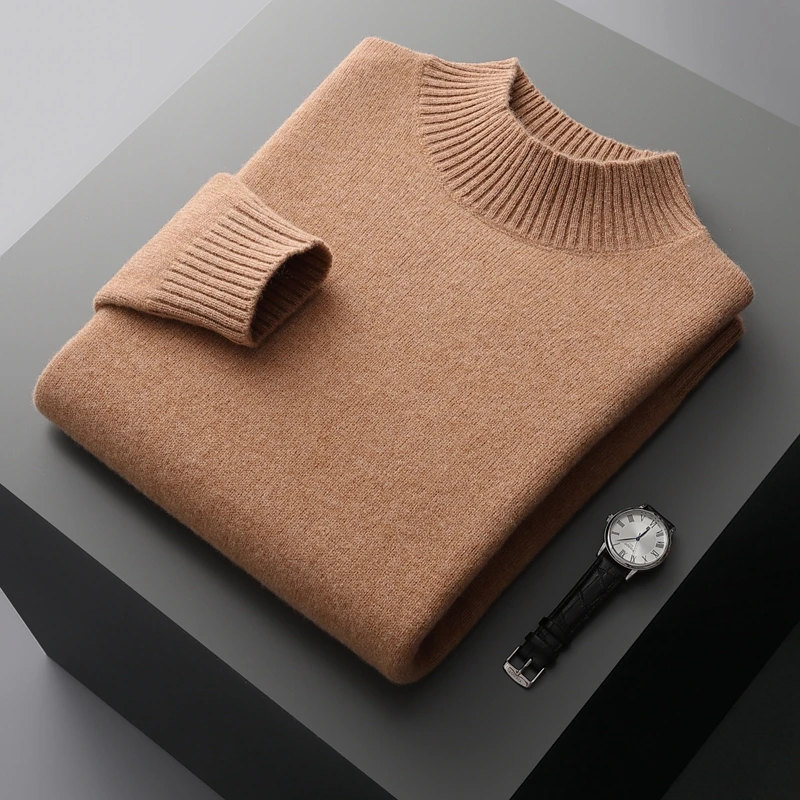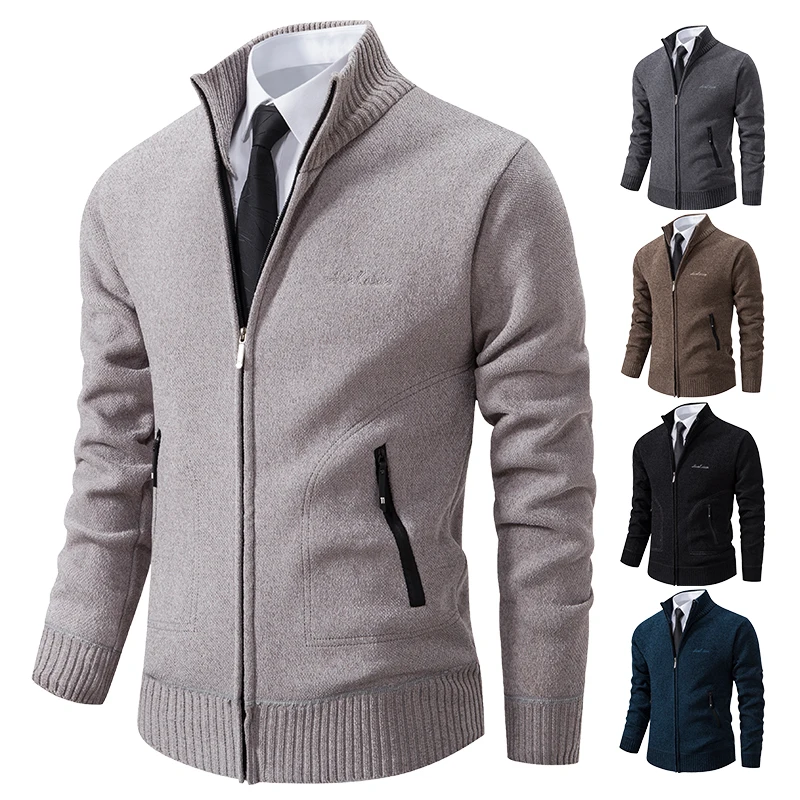Introduction: Understanding Cashmere Quality Through Gauge
When exploring the world of luxury cashmere, you’ll quickly discover that not all cashmere garments are created equal. One of the most critical yet frequently misunderstood factors affecting cashmere quality is its gauge. Understanding this crucial element can dramatically enhance your ability to select the perfect cashmere piece for your needs.
Gauge fundamentally determines how thick or thin a cashmere garment will be, affecting everything from its weight and warmth to its drape and seasonal versatility. The same premium cashmere fiber can yield remarkably different garments depending solely on the gauge at which it’s knitted.
Many consumers mistakenly believe that cashmere thickness relates directly to quality, when in reality, it’s simply a characteristic that determines how the garment will perform and feel. The perfect gauge depends entirely on your specific needs and preferences, rather than representing an absolute measure of quality.
Throughout this guide, we’ll explore how gauge numbers translate to physical properties, the distinct characteristics of different gauge categories, and how to evaluate cashmere gauge when shopping. Armed with this knowledge, you’ll be empowered to make more informed decisions when investing in your next cashmere piece. For additional insights, exploring various styling tips for cashmere cardigans can help you appreciate how gauge affects versatility.
What is Cashmere Gauge and How is it Measured?
Cashmere gauge, often abbreviated as “GG” in industry terminology, refers to the number of stitches per unit of measurement in knitted cashmere fabric. Specifically, it indicates how many stitches fit into one inch (or 2.54 centimeters) of fabric. This measurement directly determines how fine or thick the resulting fabric will be.
Definition: Gauge (GG) = Number of stitches per inch of knitted fabric
In commercial cashmere production, gauge is typically measured using specialized tools that count stitches along a horizontal line in the fabric. The measurement is taken from the finished fabric or directly from the knitting machine settings. For example, a 7GG designation means there are 7 stitches per inch, while a 14GG designation indicates 14 stitches per inch.
The difference between these measurements is significant and immediately apparent in the finished product. When examining two cashmere sweaters side by side—one knit at 7GG and another at 14GG—you would notice the 7GG fabric appears much thicker and more substantial, with visible individual stitches. The 14GG fabric would appear smoother, with less defined stitch definition.
Industrial knitting machines are designed to operate at specific gauges, which is why you’ll often see cashmere described using standard gauge numbers rather than custom measurements. Most commercial cashmere falls between 3GG (very thick) and 21GG (extremely fine).
Understanding how to properly choose the right cashmere thickness for your specific needs starts with grasping this fundamental measurement concept.
The Fundamental Relationship: How Gauge Affects Cashmere Thickness
The relationship between gauge number and cashmere thickness follows a simple inverse principle: as the gauge number increases, the thickness of the fabric decreases. This counterintuitive relationship is essential to understanding cashmere properties.
When cashmere is knit at a low gauge (such as 5GG), the knitting needles are wider apart, creating larger, more substantial stitches. These larger stitches result in a thicker, heavier fabric with more space between stitches. Conversely, when cashmere is knit at a high gauge (like 16GG), the needles are closer together, creating smaller, tighter stitches that produce a thinner, more refined fabric.
To visualize this relationship, imagine the same amount of cashmere yarn being used to create two different sweaters:
- A 7GG sweater would have fewer, larger stitches, creating a thick, chunky appearance
- A 16GG sweater would have many more, smaller stitches, creating a smooth, fine appearance
This difference isn’t just visual—it fundamentally changes how the garment feels, drapes, and performs. The lower gauge fabric will feel substantially heavier and more substantial in your hands, while the higher gauge fabric will feel lighter and more delicate.
Interestingly, the physical weight of yarn used might be similar in both cases, but the resulting fabric density and thickness vary dramatically. This explains why two cashmere sweaters with different gauges can have such distinct characteristics despite being made from identical quality fibers.
For those interested in exploring different gauge options, our collection of cashmere sweaters showcases various thicknesses to suit different preferences and needs.
Cashmere Gauge Classifications: From Chunky to Ultra-Fine
Cashmere garments typically fall into three primary gauge categories, each with distinct characteristics and ideal uses. Understanding these classifications helps you identify the right type of cashmere for specific purposes.
| Gauge Range | Thickness | Feel | Common Uses | Best Season |
|---|---|---|---|---|
| Low (3-7GG) | Thick | Substantial, plush | Chunky sweaters, outerwear | Winter |
| Medium (8-12GG) | Moderate | Versatile, balanced | Everyday sweaters, cardigans | Fall/Winter |
| High (14-21GG) | Fine | Silky, lightweight | Lightweight layers, fine knits | Year-round, Summer |
Low Gauge (3-7GG)
Low gauge cashmere creates thick, substantial garments with prominent stitch definition. These pieces have exceptional warmth-to-weight ratio and create a visually impressive, textured appearance. The looser knit structure creates air pockets that provide excellent insulation, making these garments ideal for cold weather.
Medium Gauge (8-12GG)
The middle range represents the most versatile and commonly found cashmere garments. These pieces balance warmth with reasonable weight and offer good durability for everyday wear. Medium gauge cashmere maintains some stitch definition while providing a smoother appearance than low gauge options.
High Gauge (14-21GG)
High gauge cashmere creates exceptionally fine, lightweight fabric with minimal stitch visibility. These garments excel in drape and elegance, offering a silky hand-feel and refined appearance. While less insulating than lower gauges, fine cashmere can be surprisingly warm for its weight due to the natural insulating properties of the fiber.
Our cashmere turtlenecks collection demonstrates how different gauge measurements translate to different wearing experiences across seasons.
Low Gauge Cashmere (3-7GG): Characteristics and Best Uses
Low gauge cashmere creates distinctively thick, substantial garments with several unique properties:
- Exceptional warmth: The loose knit structure creates insulating air pockets that trap body heat effectively
- Visible texture: Pronounced stitch definition creates visual interest and a craft-like appearance
- Substantial feel: Heavier weight provides a comforting, enveloping sensation
- Relaxed drape: Hangs in looser, more structural folds rather than conforming closely to the body
- Durability against friction: More resistant to everyday abrasion due to thicker yarn construction
Low gauge cashmere excels in creating statement winter pieces like chunky turtlenecks, oversized cardigans, and luxurious blankets. These items make perfect cold-weather companions when maximum warmth is the priority. The substantiality of low gauge cashmere also makes it ideal for outerwear pieces like sweater coats or heavy scarves.
From a care perspective, low gauge cashmere has some advantages. While it may be more prone to stretching due to its looser structure, it’s often more forgiving of minor snags that might be very visible in finer gauge cashmere. The substantial nature of the fabric also means pills can often be removed without compromising the garment’s integrity.
Understanding how geographic origin affects cashmere softness and durability can provide additional context for evaluating low gauge cashmere quality beyond just the gauge measurement.

Medium Gauge Cashmere (8-12GG): The Versatile Middle Ground
Medium gauge cashmere represents the sweet spot of versatility in the cashmere spectrum. This range balances the best qualities of both thicker and finer knits, creating exceptionally wearable garments suitable for diverse settings and seasons.
Key characteristics of medium gauge cashmere include:
- Balanced weight that offers warmth without bulkiness
- Moderate stitch definition that provides visual texture without being chunky
- Versatile drape that works well in both structured and relaxed silhouettes
- Good durability for regular wear while maintaining refinement
- Excellent transition-season functionality (spring and fall)
This gauge range is particularly well-suited for everyday cashmere pieces that see regular wear. Classic V-necks, crew necks, and traditional cardigans are often knit in medium gauges because they provide the ideal balance of comfort, durability, and elegance. The moderate weight also makes these pieces appropriate for indoor wear in climate-controlled environments.
For many cashmere enthusiasts, medium gauge pieces form the foundation of their luxury knitwear collection. These versatile garments can be dressed up or down and layered effectively through multiple seasons. They maintain their shape well with proper care and offer excellent longevity with regular wear.
Our cashmere cardigans collection showcases the versatility of medium gauge knits in various classic and contemporary designs.
High Gauge Cashmere (14-21GG): Luxurious Lightness and Drape
High gauge cashmere creates exceptionally fine, lightweight fabrics with remarkable fluidity and elegance. These garments represent some of the most sophisticated expressions of cashmere craftsmanship, offering distinctive qualities that make them prized additions to a luxury wardrobe.
The most notable characteristic of high gauge cashmere is its extraordinary drape. The fine knit creates fabric that flows beautifully around the body, producing elegant silhouettes impossible to achieve with thicker knits. This exceptional movement gives high gauge cashmere a distinctly luxurious appearance.
Beyond aesthetics, high gauge cashmere offers several practical advantages:
- Lightweight comfort that never feels bulky or restrictive
- Year-round wearability, including warmer seasons
- Excellent layering capability without adding bulk
- Refined appearance suitable for formal and business settings
- Ability to showcase intricate stitch patterns and details
Fine gauge cashmere is typically found in elegant cardigans, lightweight sweaters, knit shells, and refined tops designed for versatility across seasons. These pieces often command premium prices due to both the additional yarn required (more stitches per inch means more total yarn) and the sophisticated machinery needed to create such fine knits.
For those who appreciate subtle luxury, high gauge cashmere offers unmatched refinement and sophistication. While these pieces require gentle handling, their exceptional drape and elegant appearance make them worthy investments for those seeking the ultimate in cashmere luxury.

Gauge vs. Ply: Understanding the Critical Difference
One of the most common sources of confusion in cashmere terminology is the distinction between gauge and ply. While related, these terms refer to entirely different aspects of cashmere construction:
Ply refers to the number of individual yarn strands twisted together to create the thread used for knitting. Single-ply cashmere uses one strand, two-ply uses two strands twisted together, and so on. More plies generally create stronger, more durable yarn.
Gauge refers to how tightly or loosely that yarn is knitted—specifically, how many stitches fit into one inch of fabric. This determines the thickness and density of the finished fabric.
These two characteristics operate independently. The same two-ply cashmere yarn could be knit at 7GG to create a chunky sweater or at 16GG to create a fine knit. Similarly, both single-ply and two-ply yarns can be knit at identical gauges, though the resulting fabrics would have different durability profiles.
Common combinations in luxury cashmere include:
– Two-ply yarn at 12GG: Creates versatile, everyday luxury pieces
– Two-ply yarn at 7GG: Creates substantial winter garments
– Two-ply yarn at 16GG: Creates refined, elegant pieces with good durability
It’s important to note that higher ply does not necessarily mean thicker fabric if the gauge is adjusted accordingly. A four-ply cashmere knit at 16GG might actually produce a fabric similar in thickness to a two-ply knit at 12GG, but with enhanced durability and resistance to pilling.
For men seeking versatile options across different constructions, our men’s cashmere pullovers showcase various combinations of ply and gauge.
How Gauge Influences Key Cashmere Properties
Cashmere Wrap Sweaters, Women's Cashmere Pullovers
$75.89 Select options This product has multiple variants. The options may be chosen on the product pageCashmere Cable Knit Sweaters, Women's Cashmere Pullovers
Price range: $111.82 through $112.93 Select options This product has multiple variants. The options may be chosen on the product pageCropped Cashmere Sweaters, Women's Cashmere Pullovers
$155.77 Select options This product has multiple variants. The options may be chosen on the product page- Price range: $102.02 through $109.37 Select options This product has multiple variants. The options may be chosen on the product page
Oversized Cashmere Sweaters, Plus Size Cashmere Sweaters, Women's V-Neck Cashmere Sweaters
$136.87 Select options This product has multiple variants. The options may be chosen on the product page- Price range: $108.11 through $130.03 Select options This product has multiple variants. The options may be chosen on the product page
The gauge of cashmere directly impacts numerous performance characteristics that affect your wearing experience:
Warmth and Insulation
– Lower gauge (thicker) cashmere typically provides more warmth due to the air pockets created by larger stitches
– Higher gauge can still offer surprising warmth despite its lighter weight, thanks to cashmere’s natural insulating properties
– Medium gauge offers the most versatile thermal regulation across varied conditions
Drape and Movement
– Higher gauge cashmere flows more gracefully and conforms more closely to the body
– Lower gauge creates more structured, substantial draping with less fluidity
– Drape directly impacts how formal or casual a garment appears
Durability Factors
– Medium gauges (8-12GG) often provide the best balance of durability and refinement
– Very high gauge fabrics may be more vulnerable to snags due to their delicate nature
– Lower gauge fabrics resist everyday abrasion better but may lose shape more easily
Pilling Tendency
– Gauge itself doesn’t determine pilling, but it affects how visible pills become
– Pills on higher gauge fabrics tend to be more noticeable due to the smooth background
– The relationship between ply and gauge significantly impacts pilling resistance
Weight and Hand-feel
– Lower gauge creates a substantial, comforting weight
– Higher gauge offers lightweight, barely-there comfort
– The perceived weight significantly impacts the emotional experience of wearing cashmere
Understanding how to properly care for different types of cashmere helps preserve these properties regardless of gauge.
Is Higher Gauge Cashmere Always Better Quality?
A common misconception among cashmere shoppers is that higher gauge (finer) cashmere automatically indicates superior quality. This assumption is incorrect and can lead to disappointing purchases if not properly understood.
Gauge is simply a characteristic that determines the fabric’s physical properties—not an absolute indicator of quality. The true determinants of cashmere quality are:
Fiber Length: Longer cashmere fibers (typically 36mm+) create stronger, more durable, and softer yarn regardless of gauge.
Fiber Diameter: Premium cashmere has fibers under 16 microns in thickness, creating the characteristic softness associated with luxury cashmere.
Cashmere Grade: Grade A cashmere refers to fiber quality (length and diameter), not gauge or thickness.
Manufacturing Precision: The consistency of stitching, finishing techniques, and quality control matters more than gauge number.
A 7GG sweater made from premium long-fiber Grade A cashmere will be superior to a 16GG sweater made from shorter, coarser fibers. The best gauge depends entirely on your intended use and preferences rather than representing an absolute quality hierarchy.
When evaluating cashmere quality, look beyond gauge to assess fiber characteristics, construction quality, and brand reputation. Understanding why cashmere commands premium prices helps put gauge selection in proper perspective alongside other quality factors.

Choosing the Right Cashmere Gauge for Your Needs
Selecting the appropriate cashmere gauge should be a deliberate decision based on your specific needs rather than assumptions about quality. Consider these key factors when determining the ideal gauge for your next cashmere purchase:
Climate Considerations
– Cold climates benefit from low to medium gauge (3-10GG) for maximum warmth
– Moderate climates are best served by medium gauge (8-12GG) for versatility
– Warm climates or heated indoor environments call for high gauge (14GG+) options
Usage Context
– Professional settings often demand the refined appearance of higher gauge cashmere
– Casual, everyday wear benefits from durable medium gauge pieces
– Statement pieces and winter-specific items excel in lower gauges
Personal Comfort Preferences
– Those who prefer substantial, cozy garments should opt for lower gauges
– If you dislike weight or bulk in knitwear, higher gauges offer lightweight comfort
– Sensitivity to texture may influence your gauge preference
Maintenance Considerations
– Higher gauge cashmere typically requires more careful handling
– Medium gauge offers the best balance of durability and refinement
– If you prefer low-maintenance luxury, slightly lower gauges may be preferable
When shopping online where touch isn’t possible, pay attention to descriptive terms like “fine knit” (typically 14GG+), “medium knit” (8-12GG), or “chunky/heavy knit” (3-7GG). Close-up photos can also reveal stitch definition that indicates gauge category.
For year-round versatility, consider 12-14GG cashmere that bridges seasons effectively. These middle-range gauges offer exceptional versatility while maintaining elegant drape. Our guide to versatile cashmere cardigan styles provides additional insights into selecting adaptable pieces.
Gauge and Investment Value: Longevity Considerations
The gauge of your cashmere significantly impacts its long-term investment value, affecting everything from durability to versatility. Understanding these relationships helps ensure your luxury purchases stand the test of time.
Medium gauge cashmere (10-12GG) typically offers the best balance of durability and refinement for everyday luxury pieces. These garments resist wear while maintaining elegant drape, making them practical investments for regular use. The moderate stitch density provides resilience against common wear patterns while still offering sophistication.
Lower gauge cashmere, while exceptionally warm and cozy, may be more prone to stretching over time. The larger stitches can lose their structure with repeated wear, particularly in high-stress areas like elbows and cuffs. However, these pieces often show less visible pilling due to the textured surface that camouflages small fiber balls.
Higher gauge cashmere presents its own maintenance profile. While the fine knit creates unmatched elegance, it requires gentle handling to preserve its refined character. The significant price premium for ultra-high gauge cashmere (16GG+) reflects both material requirements and the specialized craftsmanship involved.
Longevity Tips by Gauge:
– Low gauge (3-7GG): Store flat rather than hanging to prevent stretching
– Medium gauge (8-12GG): Ideal for regular rotation with minimal special care
– High gauge (14GG+): Handle with extra care to prevent snags and pulls
Remember that proper care dramatically extends the lifespan of any cashmere regardless of gauge. Following appropriate layering techniques with cashmere cardigans can also help preserve their structure and appearance.
How to Evaluate Cashmere Gauge When Shopping
Assessing cashmere gauge during the shopping process requires attention to specific visual and tactile cues, especially when precise specifications aren’t provided.
Visual Assessment Techniques:
1. Hold the fabric up to light – higher gauge fabrics appear more translucent
2. Examine stitch definition – prominent, visible individual stitches indicate lower gauge
3. Check fabric thickness between your fingers – substantial thickness suggests lower gauge
4. Look for surface texture – smoother appearance typically indicates higher gauge
Shopping Language Decoder:
– “Fine gauge” typically indicates 14GG or higher
– “Medium weight” usually refers to 10-12GG
– “Chunky” or “heavy knit” suggests 7GG or lower
– “Lightweight” almost always means 12GG+
When shopping from premium retailers, don’t hesitate to request specific gauge information before purchasing investment pieces. Quality brands typically specify exact gauge measurements for their cashmere garments, either on product tags or in detailed descriptions.
Pay attention to price as an indirect indicator—ultra-fine gauge cashmere requires more material and sophisticated manufacturing, typically commanding higher prices than comparable quality in lower gauges. However, price alone cannot determine gauge, as fiber quality and brand positioning also significantly impact pricing.
If possible, compare the item to reference pieces whose gauge you already know. This side-by-side comparison offers the most reliable assessment when technical specifications aren’t available.
Is Cashmere Gauge Always Clearly Labeled?
Unfortunately, cashmere gauge isn’t consistently labeled across the industry, creating challenges for informed consumers. While premium luxury brands typically specify exact gauge measurements, many retailers provide only vague descriptions or omit gauge information entirely.
When precise gauge specifications aren’t provided, manufacturers often use alternative descriptive terminology:
– “Superfine” typically indicates 16GG or higher
– “Fine knit” usually refers to 14GG+
– “Medium knit” suggests 10-12GG
– “Heavy knit” or “chunky” indicates 7GG or below
Some retailers deliberately avoid technical specifications to prevent direct comparisons or to mask production variations. This practice is particularly common in mid-market cashmere where consistency may vary between production runs.
When gauge isn’t specified, examine the price point carefully. Ultra-fine gauge cashmere commands premium prices due to material requirements and manufacturing complexity. A suspiciously affordable “fine knit” cashmere piece may indicate compromises in either gauge consistency or fiber quality.
If gauge information matters to your purchasing decision, particularly for investment pieces, contact the retailer directly to request specifications. Reputable sellers should be able to provide this information or explain why it varies. Absence of this knowledge may suggest limited quality control in the production process.
Common Questions About Cashmere Gauge
Does gauge affect how much a garment will pill?
Gauge itself doesn’t directly determine pilling tendency, but it affects how visible pills become. The primary factors in pilling are fiber length and twist level. However, pills on higher gauge fabrics tend to be more noticeable due to the smooth background, while lower gauge fabrics can sometimes camouflage minor pilling within their textured surface.
Can you determine gauge after purchase?
Yes, with some practice. Count the number of stitches in one inch of the fabric using a ruler and magnifying glass if necessary. This gives you an approximate gauge measurement, though industrial knitting may have slight variations from hand-counting methods.
Why are higher gauge cashmere garments often more expensive?
Higher gauge cashmere typically requires more yarn per garment despite appearing thinner, as the tighter stitches use more total length of yarn. Additionally, producing very high gauge knits requires more sophisticated manufacturing technology and quality control, adding to production costs.
Do different regions specialize in different gauge cashmere?
While cashmere fiber quality varies by region, gauge is primarily a manufacturing decision rather than a regional characteristic. However, some production regions have developed expertise in particular gauge ranges based on local manufacturing traditions and equipment specialization.
Is gauge relevant for all cashmere items?
Gauge is most relevant for knitted cashmere garments. For woven cashmere items like scarves or cashmere-blend fabrics, different measurements like thread count or fabric weight per square yard become more important quality indicators.
Conclusion: Making Informed Cashmere Choices Based on Gauge
Understanding cashmere gauge empowers you to make more nuanced decisions when investing in luxury knitwear. Rather than viewing gauge as a simple quality indicator, recognize it as a characteristic that determines how a garment will perform for your specific needs and preferences.
The perfect cashmere gauge balances your requirements for warmth, drape, and durability. Low gauge pieces offer exceptional warmth and substantial feel, medium gauge provides versatile everyday luxury, and high gauge delivers unmatched refinement and elegant drape. Each has its proper place in a well-curated wardrobe.
When evaluating cashmere, remember that gauge is just one factor alongside fiber quality, construction, and design. A truly exceptional cashmere piece combines the appropriate gauge for its intended use with premium fibers and meticulous craftsmanship.
With the knowledge from this guide, you can now assess cashmere beyond basic price comparisons. You’ll be able to recognize the characteristics that make each gauge category special and select pieces that truly meet your needs rather than following general assumptions about what constitutes “better” cashmere.
The luxury of cashmere lies not just in its softness and warmth, but in choosing the precise characteristics that enhance your personal comfort and style. By understanding gauge, you’ve taken an important step toward becoming a more discerning connoisseur of this extraordinary fiber.







